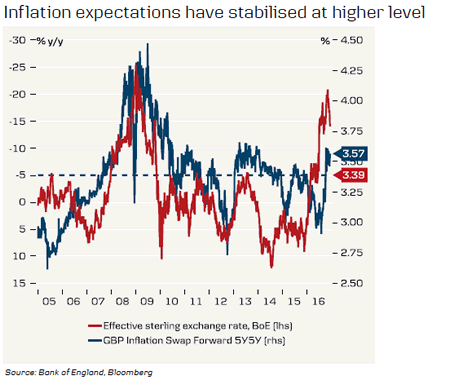We expect a 6-2 vote in favour of unchanged Bank Rate
Despite slower growth, the Bank of England (BoE) has turned more hawkish recently, as inflation has moved higher and the unemployment rate lower. Still, we do not expect a BoE rate hike before some time in 2019: GDP growth has slowed and has been weaker than the BoE anticipated, high inflation is temporary due to the weak GBP caused by Brexit, wage growth remains weak and does not indicate high underlying inflationary pressure and political uncertainty is high. We still view the core of the Monetary Policy Committee (including governor Mark Carney) as being tilted to the dovish side.
At this meeting, we expect the BoE to vote 6-2 in favour of keeping the Bank Rate unchanged against 5-3 on the previous occasion. The reason is mainly because Kristin Forbes, a known hawk voting for a hike, has left the committee and we do not think the new member will vote against Carney at the first meeting. Andy Haldane was leaning towards a hike in his recent speech but we think the August meeting is still too early for him to jump camp.
We expect the BoE to revise down its projection for GDP growth, reflecting that it has been too optimistic so far in 2017 and that growth is set to remain around the current level in coming quarters. The inflation path is likely to be broadly unchanged while the projection for the unemployment rate is likely to show a stabilisation around the current level of 4.5%.
When the BoE launched its big easing package in August 2016, it promised to consider whether the so-called Term Funding Scheme (TFS) should continue beyond February 2018 or not at the upcoming August 2017 meeting. As the BoE has become more worried about consumer credit growth, we expect it to announce that the TFS will end in February 2018.
6-2 vote could trigger a renewed test of the 0.90 level in EUR/GBP
EUR/GBP is trading at the high end of the 0.84-0.90 range, which we still see as the main trading range for the cross. The recent leg higher in EUR/GBP has been driven mainly by general EUR appreciation, but June’s weaker-than-expected CPI figures from the UK also pushed the cross higher amid reduced expectations of a BoE rate hike in November.
The UK money market implicitly indicates around a 35% probability (9.5bp priced) of a November rate hike, while the timing of the first full 25bp rate hike has been pushed from July 2018 (as of 30 June) to December 2018. We still view the market’s pricing of the BoE as slightly hawkish as we see little prospects of a rate hike this year, and given the current momentum for the euro, we maintain a cautious stance on GBP near term.
If we are right that the MPC will vote 6-2 in favour of keeping interest rates unchanged at the August meeting, it is likely to be interpreted as a modestly dovish signal and could trigger a renewed test of the 0.90 level.
What matters for GBP longer term are the Brexit terms, and the ongoing Brexit negotiations will be a source of volatility in coming years. Any turning point for the British currency would probably have to be driven by reduced uncertainty about the future agreement between the UK and the EU, which could entice foreign investors back to Britain. However, given the British government’s weak parliamentary majority, we see little likelihood that skies will clear for GBP in the coming 12 months. Generally, we recommend investors and corporates hedging GBP assets/income to maintain a high hedge ratio.
35% probability of a BoE hike this year, according to market pricing
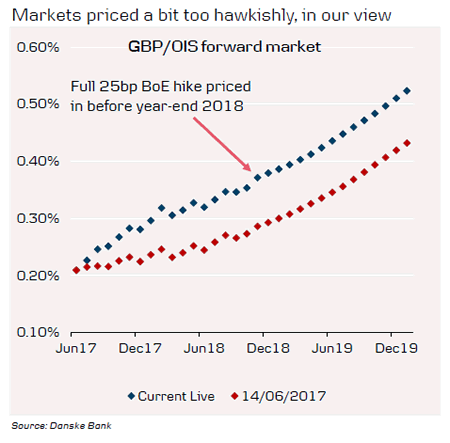
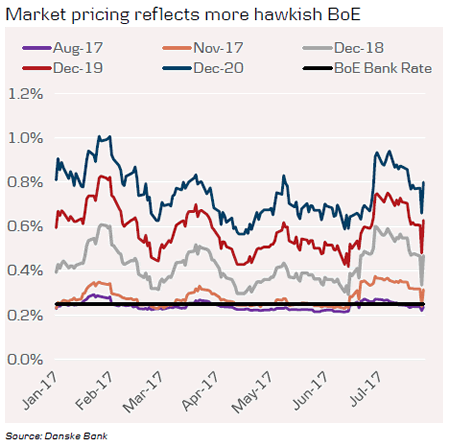
Actual inflation in line with expectations from the latest Inflation Report (IR)
Actual inflation in June was in line with the BoE’s latest projection, as it fell back to 2.6% after the big jump in May to 2.9%.
The very high inflation print in May was one of the reasons why the BoE turned more hawkish, but the fall in June is likely to calm neutral BoE members.
We expect the updated inflation path to be broadly unchanged.
The BoE has consistently been too optimistic on wage growth and hence underlying inflation. This is also one reason why we do not think the BoE will hike soon.
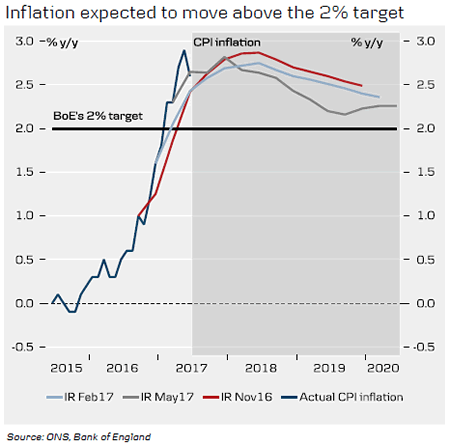
Weaker growth than expected
UK GDP grew by 0.3% q/q in Q2 after 0.2% q/q in Q1 (which was the lowest among EU member states) and the performance in H1 17 has been the weakest since the European debt crisis.
This was 0.1pp below the BoE’s forecast of 0.4% and the BoE has now underestimated growth in both Q1 and Q2.
The GDP growth path is likely to be revised down reflecting that the BoE was wrong and that growth is likely to continue at around the same pace in coming quarters.
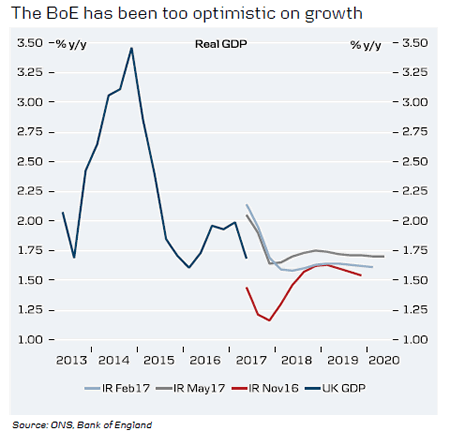
Unemployment rate is now at NAIRU
Although the BoE revised down its projection for the unemployment rate in May, the unemployment rate continues to fall against expectations and is now at the BoE’s NAIRU estimate of 4.5%.
This is another reason why the BoE has turned more hawkish, as members see only a ‘small degree of spare capacity’ left in the economy.
We expect the projection for the unemployment rate to be revised down in the updated projections.
The new path is likely to show the unemployment rate will stay at around the current level.
That said, the tight labour market has not translated into higher wage growth yet and given NAIRU is unobservable, the BoE may revise down its NAIRU estimate further at some point (not necessarily at this meeting).
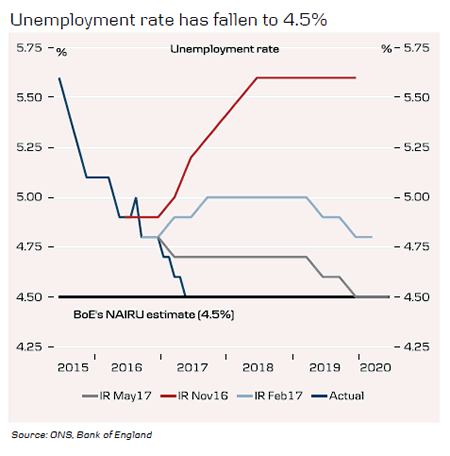
GDP growth in H1 17 the weakest since the European debt crisis


PMIs indicated growth remained weak in Q2

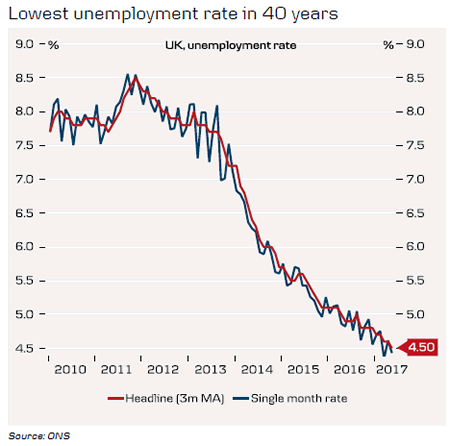
Weaker GBP => higher import prices => higher inflation => eroding purchasing power
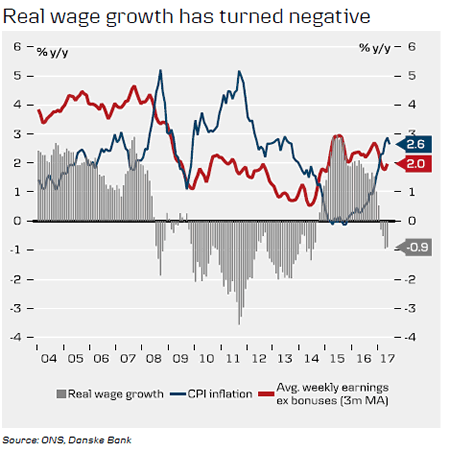
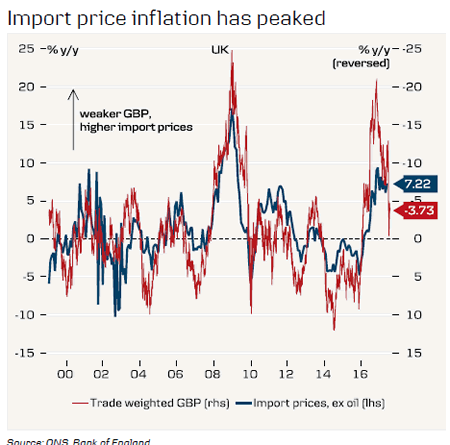
Commodity prices have also pushed up inflation
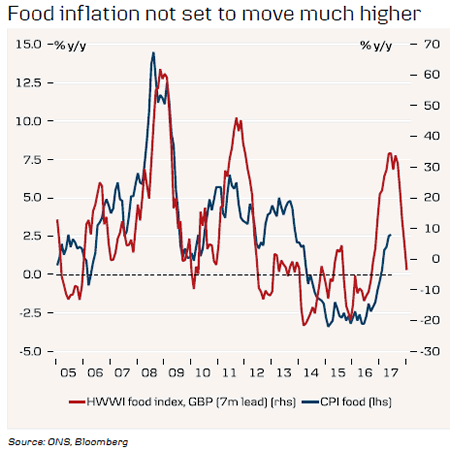
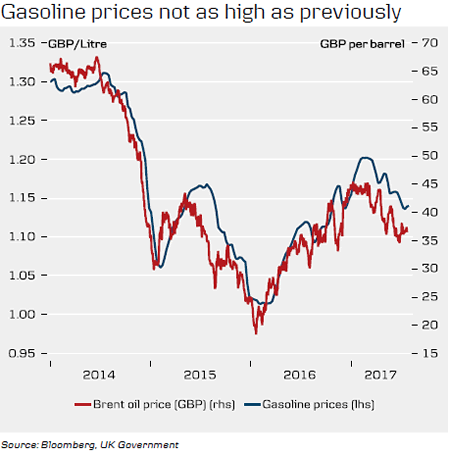
Inflation expectations have stabilised at higher level
